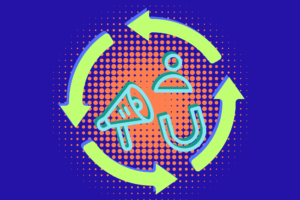Table of Contents
You’ve probably heard the phrase “Content is King” and you may be tinkering with your own content. Maybe you’ve posted a few blogs here and there. You’ve published your work and watched and waited.
Then nothing. Crickets.
Even one experience like that is enough to turn anyone off from content marketing, but it’s not the end of the world. You’ve probably committed one of the cardinal content marketing sins below. The good news? We can help you fix it so your content reaches the right people — and delivers exactly what they want.
You Don’t Have a Strategy
Are you posting ad hoc articles “when you get the chance”? Are you one of the 31% of marketers that don’t have a documented content strategy? If you’re not thinking strategically about content, you’re missing the point. Sure, a few articles here and there might keep your blog from being entirely blank, but you’re losing out on all the possible benefits.
To begin thinking strategically about your content, ask yourself the following questions:
- What is my vision for content/content marketing (goals, business objectives, etc.)?
- How often can I commit to publishing content and how often is necessary to achieve my goals?
- Who is my audience?
- What does my audience want to know?
- Where does my audience go for content/research?
- What is our brand voice?
Purposeful content marketing means you have a plan behind the content you produce. When you execute a strategy, you’re more likely to create meaningful content that resonates with your target audience.
Once you have a better idea about your audience and what they want to know, you can start to build out a content calendar. This will outline the topics you’ll cover, the dates you’ll publish, and where you’ll publish and promote content.
Your Posting Schedule is Erratic
If you find yourself posting blogs once every three months or three times one month and then nothing for two months, you have a frequency problem. In order to captivate your audience, you need to prove to them that you are reliable. Reliability comes from establishing — and sticking to — a publishing cadence. Obviously, quality trumps quantity. However, if you lack consistency in your content publishing, you will have a hard time building credibility and trust with your audience. You’ll also have a hell of a time ranking with search engines.
If you’re not sure how frequently you should publish, consult your audience. By that, I mean run tests. Start by publishing weekly. Then consider bumping up the frequency to two blog posts per week. If you have the capacity, try blogging every day. Pay close attention to your Google Analytics. In some cases, your audience may not have the desire (or the time) to hear from you every single day. Very frequent publishing can also result in lower-quality content, which can also drive an audience away. Fine-tune your content calendar until you find the perfect cadence for your brand.
Quick tip: Mix up media. Instead of relying solely on written blog posts, consider posting video or audio content. Infographics are also a great way to present information in a visually appealing manner. Almost three-quarters (73%) of B2B marketers say they have less time to read content and spend time researching, so finding creative ways to present information quickly can be beneficial, especially in the awareness stage.
You’re Selling People to Death
If you’re using content purely as a sales pitch, you’re doing it wrong. While the end game of content marketing may be to drive new business, your content must serve much more nuanced purposes than simply selling.
Between self-service and online research, nearly 60% of B2B buyers are no longer relying on sales reps. That doesn’t mean your content should step in and do the selling. In fact, many B2B buyers are simply connecting with sales reps later along in the process. This means that your content must successfully educate them along the way. Content must be organized and developed so that buyers have support at every stage in the buying process.
Awareness — Drive awareness and educate an audience that needs to better understand a problem or a solution. Use:
- Educational blog posts
- Social Media content
- Snackable content (infographics, shorter posts, shareable content)
Consideration — Aid buyers’ more in-depth research that is likely product/solution-focused at this point. Use:
- Blog posts that educate, explain trends, highlight news
- Infographics that tell a story
- White papers
- Thought leadership
Decision — This will be the most specific in terms of products and services, but should still steer away from outright selling. Aim to be helpful and to provide as much information as possible via:
- Blog posts that compare products/services
- White papers
- Survey/Research results
- Industry Reports
- Competitive comparison charts/guides
You’re Talking to the Wrong People
It’s more important than ever to understand who your audience is. At the beginning of 2020, experts estimated that the digital universe consisted of 44 zettabytes of data. Good luck cutting through that noise! The best results come from developing highly detailed audience personas that can steer content creation.
Audience personas answer very important questions like:
- What roles/titles are going to buy your product/service?
- What demographics are looking for your products/services?
- Where is your target audience located?
- What information is my audience interested in?
- What questions does my audience have?
- Where does my audience currently go for information/research?
- What is my audience’s biggest problem?
- What does my audience need the most?
Answering these questions — through Google Analytics, by surveying your sales team, and via market research — will set you up to create the most tailored, compelling content possible for the people you’re trying to reach. It gets a whole lot easier to reach people when your content speaks to exactly what they need.
Your Content Reads Like Siri Scanning Used Car Ads
We will beat this dead horse until it comes back to life: trust and credibility matter! Do you know what doesn’t foster trust and credibility? Bland, boring content that is devoid of any personality. People buy from people they like, but more importantly, people buy from other people. Stop creating content that resembles a mechanical, droning laundry list of facts and figures. Add some flair and flavor! Adopt a tone and voice that your audience can become familiar with and to which they can relate.
Yes, having an authoritative grasp on the issues at hand is important, but that doesn’t mean that you need to adopt an authoritative tone. Aim to come across as friendly, helpful, and honest. Use personalization to build a rapport with your audience, but be careful not to fall into the over-automation trap. Technology has facilitated some smart marketing, but overly automating your marketing content can lead to snafus and have the opposite that personalization is meant to have.
Conclusion
Given the wealth of information that buyers have access to online, you’d be well advised to avoid creating more content simply for the sake of….creating more content. Instead, get strategic with your content and content marketing. Establish your goals, build a plan, and consistently execute on that plan.
Once you establish who your audience is, personalize content to meet the audience’s needs at every step along the buyer’s journey. Be personable, helpful, and honest. Use your content to guide, educate, and connect with your target audience until they’re ready to buy.



